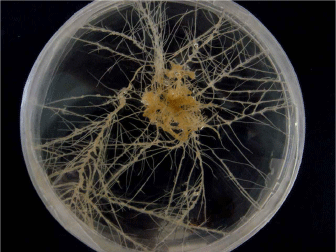Agrobacterium rhizogenes is the bacteria that causes hairy root disease, this has some uses, as has been discussed else where on this forum. I am interested in a method in obtaining Agrobacterium rhizogenes.
The only source I've found is this one, and it costs $155.00 dollars, which for bacteria, is just a little bit over priced, I think.
http://www.atcc.org/ATCCAdvancedCatalogSearch/ProductDetails/tabid/452/Default.aspx?ATCCNum=11325&Template=bacteria
How about some method of getting it from the soil? I know most Agrobacterium bacteria will swim towards phenolic compounds, since this generally implies roots of plants have been injured, and that allows them to enter the plant and cause problems such as hairy root disease or crown gull.
I think getting them this way is a slim chance to none -- I assume making a tea of some fairly phenolic root, or just a tea of some plant in general ought to bring them out if they exist, but then I would probably need to isolate them. I doubt they are even present in everyday soil.
Does anyone have information on how it can be obtained from the wild, or perhaps know a better source for this bacteria? I am thinking that I might just have better luck contacting a professor or a college student and get it this way -- but I don't know if they would be willing to do that or not.
Maybe if life is great, you can just add the phenolic compounds, get the soil which presumably has them in it, and then infect a plant with them by harming its roots with the 'tainted' soil present. Anyways.. some articles on how they are obtained by nature or a cheaper source would be great to see! I can't find much on them at all.
PS. This may prove to be rather difficult since the places that sell Agrobacterium tumefaciens claims it has a restriction on it, and that you need a USDA permit. I.e: http://www.carolina.com/product/living+organisms/prokaryotes/bacteria+cultures+and+sets/acetobacter+aceti%2C+living%2C+tube.do?keyword=Agrobacterium&sortby=bestMatches&page=1
However, they are only selling it for $9.50
Plus: http://www.carolina.com/product/plant+cancer+study+kit.do?keyword=Agrobacterium&sortby=bestMatches
Edit:
While this isn't the Agrobacterium rhizogenes, which is wanted, it contains some information about the isolation of A. Tumefaciens, which might prove to be useful later on.
The only source I've found is this one, and it costs $155.00 dollars, which for bacteria, is just a little bit over priced, I think.
http://www.atcc.org/ATCCAdvancedCatalogSearch/ProductDetails/tabid/452/Default.aspx?ATCCNum=11325&Template=bacteria
How about some method of getting it from the soil? I know most Agrobacterium bacteria will swim towards phenolic compounds, since this generally implies roots of plants have been injured, and that allows them to enter the plant and cause problems such as hairy root disease or crown gull.
I think getting them this way is a slim chance to none -- I assume making a tea of some fairly phenolic root, or just a tea of some plant in general ought to bring them out if they exist, but then I would probably need to isolate them. I doubt they are even present in everyday soil.
Does anyone have information on how it can be obtained from the wild, or perhaps know a better source for this bacteria? I am thinking that I might just have better luck contacting a professor or a college student and get it this way -- but I don't know if they would be willing to do that or not.
Maybe if life is great, you can just add the phenolic compounds, get the soil which presumably has them in it, and then infect a plant with them by harming its roots with the 'tainted' soil present. Anyways.. some articles on how they are obtained by nature or a cheaper source would be great to see! I can't find much on them at all.
PS. This may prove to be rather difficult since the places that sell Agrobacterium tumefaciens claims it has a restriction on it, and that you need a USDA permit. I.e: http://www.carolina.com/product/living+organisms/prokaryotes/bacteria+cultures+and+sets/acetobacter+aceti%2C+living%2C+tube.do?keyword=Agrobacterium&sortby=bestMatches&page=1
However, they are only selling it for $9.50

Plus: http://www.carolina.com/product/plant+cancer+study+kit.do?keyword=Agrobacterium&sortby=bestMatches
Edit:
While this isn't the Agrobacterium rhizogenes, which is wanted, it contains some information about the isolation of A. Tumefaciens, which might prove to be useful later on.
Quote
A. tumefaciens can be effectively isolated for identification from gall tissue, soil or water. Optimal gall tissue for isolation is white or cream-colored from a young, actively growing gall. The gall should be washed or surface sterilized using 20% household bleach, and rinsed several times in sterile water. Cut a few samples from different parts of the white tissue of the gall, and further divide samples into small pieces. Place these pieces into a culture tube containing sterile distilled water or buffer, vortex and allow to stand for at least 30 minutes. Using an inoculating loop, streak this suspension on Medium 1A (Schaad et al., 2001), and incubate at 25-27° C. Different strains will grow at different rates. One may also use this selective medium to detect A. tumefaciens in soil dilutions or irrigation water.--- http://www.cals.ncsu.edu/course/pp728/Agrobacterium/Alyssa_Collins_profile.htm
It should be noted, however, that the presence of A. tumefaciens cells in a sample does not necessarily dictate the existence of the crown gall-inciting strain in the sample. Only cells containing a specific plasmid (the Ti plasmid) can cause disease. A. tumefaciens strains lacking the plasmid live as rhizosphere-inhabiting bacteria without causing disease.










